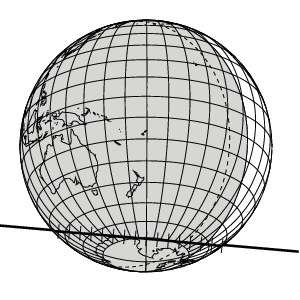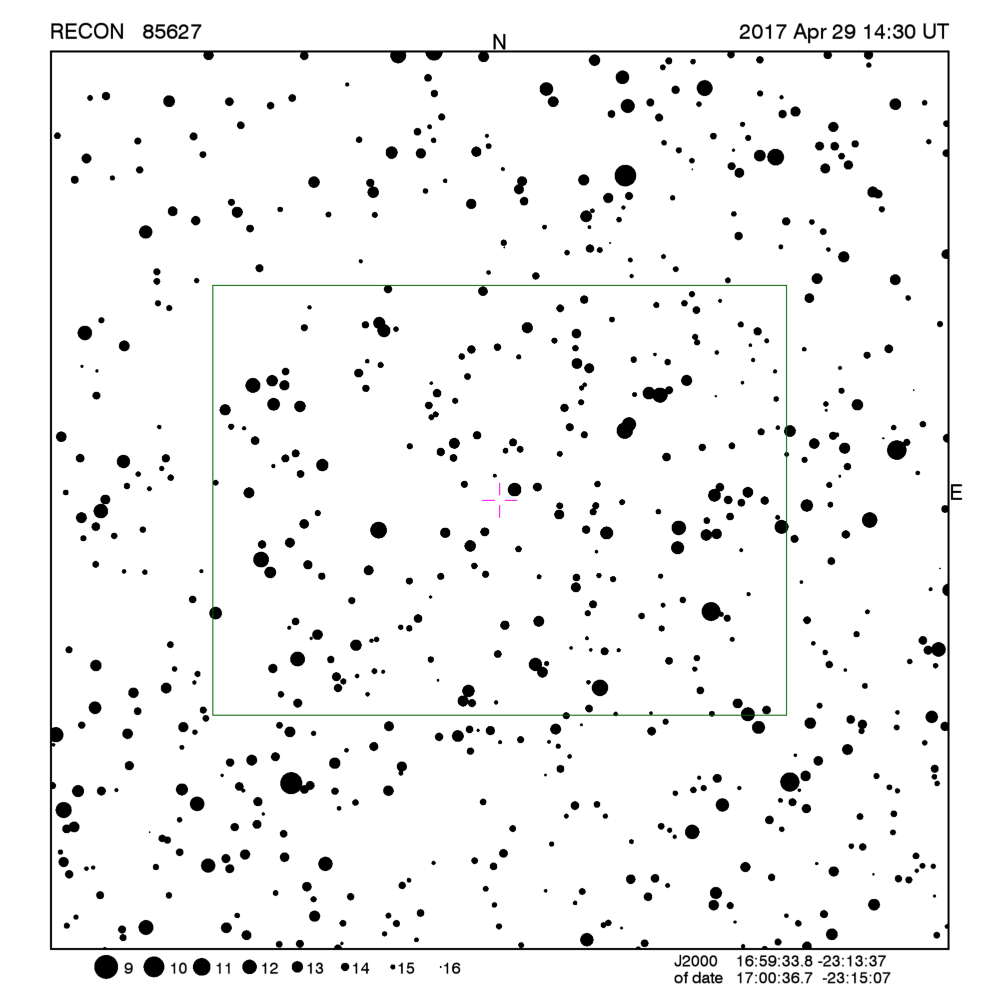RECON: TNO occultation with 85627
Event between (85627) 98HP151 and star UC4-334-087519
with event index number of 65888
Geocentric closest approach at 2017/04/29 14:30:22 UTC
J2000 position of star is 16:59:33.8 -23:13:37
Equinox of date position of star is 17:00:33.5 -23:15:02
Stellar brightness R=16.5
Star is 171 degrees from the moon.
Moon is 14% illuminated.
TNO apparent brightness V=23.6
 TNO is 41.4 AU from the Sun
and 40.6 AU from the Earth.
TNO is 41.4 AU from the Sun
and 40.6 AU from the Earth.
The TNO is moving 18.6
km/sec on the sky relative to the star, or,
2.3 arcsec/hr.
The 1-sigma error in the time of the event is 707 seconds.
The 1-sigma cross-track error in the shadow position is
2377 km.
The TNO has an absolute magnitude Hv=7.4
Diameter=199.5 km assuming a 5% albedo -- 10.7 sec chord
Diameter=81.5 km assuming a 30% albedo -- 4.4 sec chord
Dynamical classification is CLASSICAL
Star training set for 85627, (2017/04/29 14:30UT)
Object RA Dec mag sep mel
Antares 16:30:28.3 -26:28:08 0.9 7.55 164
23Tau Sco 16:36:57.8 -28:15:02 2.8 7.30 164
26 Oph 17:01:13.3 -25:00:51 5.8 1.77 170
PPM 266304 17:03:11.7 -23:18:44 8.4 0.60 172
PPM 266225 17:00:09.8 -23:23:31 9.6 0.17 171
85627 17:00:36.7 -23:15:07 16.5 172
Positions are for equinox of date

Azimuth is measured in degrees eastward from north.
North is at an azimuth of 0, due East is at an azimuth
of 90 degrees, due South is 180, and due West is 270.
Do not use the listing below for the RECON CPC 1100 telescopes.
This is provided for other non-team facilities.
Star training set for 85627, (2017/04/29 14:30UT)
Object RA Dec mag sep mel
Antares 16:29:24.4 -26:25:55 0.9 7.55 164
23Tau Sco 16:35:53.0 -28:12:58 2.8 7.30 164
26 Oph 17:00:09.6 -24:59:22 5.8 1.77 170
PPM 266304 17:02:08.7 -23:17:18 8.4 0.60 172
PPM 266225 16:59:06.9 -23:22:00 9.6 0.17 171
85627 16:59:33.8 -23:13:37 16.5 171
Positions are for J2000
Event circumstances last updated at 2016/06/07 03:09:22 UT
Marc W. Buie,
Southwest Research Institute
RECON
 TNO is 41.4 AU from the Sun
and 40.6 AU from the Earth.
TNO is 41.4 AU from the Sun
and 40.6 AU from the Earth.
